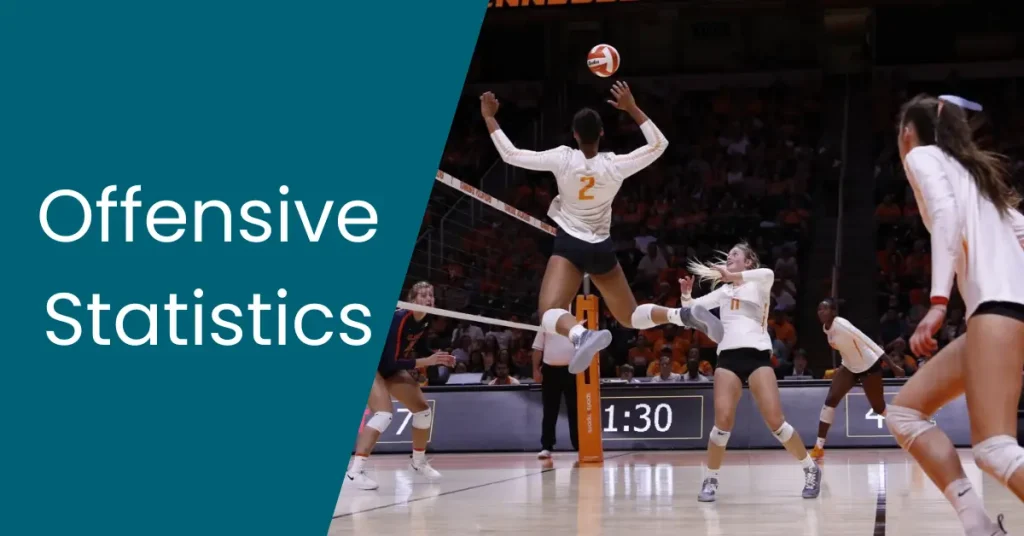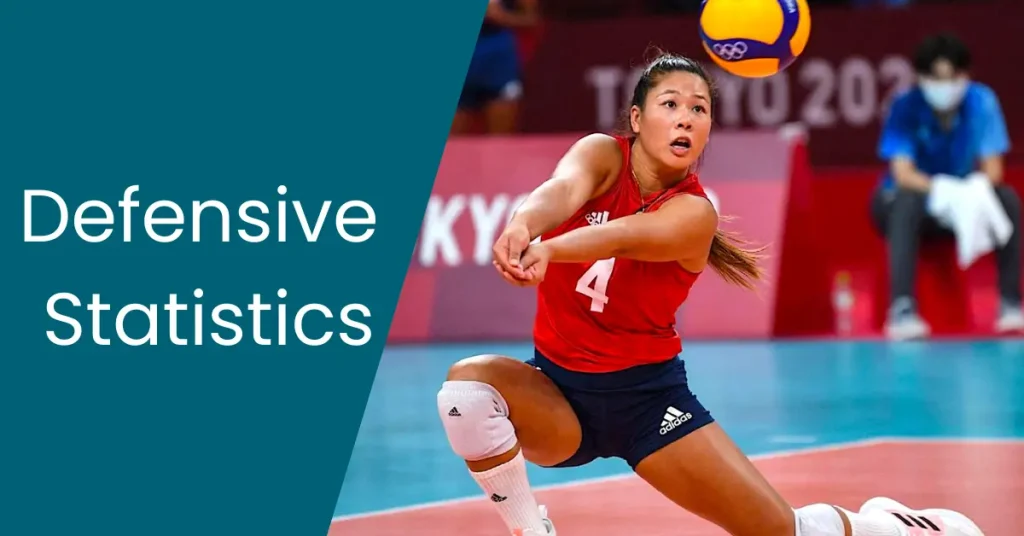Are you a volleyball enthusiast looking to dive deeper into the world of this thrilling sport? Well, get ready to serve up some knowledge. In the fast-paced game of volleyball, there’s more than meets the eye. Beyond those stunning spikes and digs lies a treasure trove of valuable information – volleyball statistics. These numbers can unlock insights into player performance, team dynamics, and overall strategy. So get ready and join me as I explore the importance of tracking volleyball statistics and uncover the different types that make this sport even more exciting.

Importance of Tracking Volleyball Statistics
Tracking volleyball statistics is a crucial game aspect that should not be overlooked. It provides valuable insights into individual and team performance, helping players and coaches identify areas of strength and weakness. By analyzing these statistics, teams can make strategic adjustments to improve their gameplay. Additionally, incorporating slot online analysis into training can further enhance performance by allowing teams to simulate various game scenarios and evaluate player responses, leading to more informed decisions during actual matches. This comprehensive approach ensures that both statistical data and practical experience contribute to overall team development.
One of the key benefits of tracking volleyball statistics is that it allows players to set goals for themselves and measure their progress over time. For example, by keeping track of kills or attack percentage, players can determine how effective they are at scoring points for their team. This information can then be used to focus on specific skills or techniques during practice sessions.
Moreover, analyzing team statistics like points scored/received or win-loss records gives teams a clear picture of their overall performance throughout a season. It helps them gauge progress over time and compare themselves against other teams in the league.
Types of Volleyball Statistics
Regarding volleyball, statistics play a crucial role in evaluating the performance of teams and individual players. By tracking various aspects of the game, coaches and analysts can gain valuable insights into strengths, weaknesses, and overall effectiveness on the court. Several types of volleyball statistics provide a comprehensive view of a team’s performance.
Offensive Statistics:
One important offensive statistic, which measures the number of successful attacks resulting in points, is killed. Attack percentage is another key metric that indicates how efficient a player or team is at converting attacks into points. A high attack percentage reflects strong offensive skills and set percentages, which are essential statistics for measuring the effectiveness of setters. It assists in tracking how often a setter sets up an attacker for a kill.
Defensive Statistics:
Digs represent successful defensive plays where players prevent the ball from hitting the ground after an opponent’s attack. Dig percentage reveals how often players successfully dig balls compared to the opportunities presented by opposing attacks.
Blocks demonstrate effective defensive teamwork as players attempt to block incoming attacks at the net before they cross onto their side of play. Block percentage evaluates success rates based on attempted blocks versus those resulting in point-saving stops.
Team Statistics:
Points scored and received give an overview of both offense and defense collectively displayed by teams throughout matches played during competitions or tournaments. A higher number indicates better performance overall.
Win-loss records keep track of victories and defeats relative to other teams within leagues or competitions, signifying success rates throughout seasons or specific periods with comparisons among competitors.

Things Noticed For Offensive Strategies:
Kills Percentage:
In volleyball, kills are one of the most important offensive statistics to track. A kill occurs when a player successfully hits the ball over the net and lands in the opposing team’s court, resulting in a point for their team. It requires skill, precision, and timing.
Attack Percentage:
Attack percentage is another crucial statistic that helps measure a player’s effectiveness on offense. It is calculated by dividing the number of kills by the number of attempted attacks. This statistic explains how often a player can convert their attack attempts into successful points for their team. The high spike percentage indicates the efficiency and accuracy in hitting, While a low attack percentage may indicate a lack of opportunities or an inability to make effective shots.
Assists Percentage:
Assists percentages are crucial statistics in volleyball that measure players’ ability to create scoring opportunities for their teammates. Assists are not just about technique; they also require understanding your teammates’ strengths and preferences to deliver precise sets that are recorded when a player sets the ball, allowing another player to make an attack. A high number of assists indicates excellent playmaking skills and court vision.
Set Percentage:
A set percentage measures the effectiveness of a setter’s decision-making and execution. It is calculated by dividing the number of successful sets by total attempts and multiplying it by 100. A higher set percentage signifies an accurate setting and helps maximize offensive opportunities.
Service Percentage:
Serve percentages are important statistics when evaluating a player’s serving skills in volleyball. An ace is recorded when a server serves the ball, and the number of aces a player accumulates can indicate their effectiveness at placing the serve strategically, forcing errors from the opposing team, or creating difficulty for them to set up an attack. It requires precision and control to deliver powerful serves that are hard to handle consistently.
A serving percentage measures how often a player successfully gets their serve over the net without committing an error like hitting it out of bounds or into the net. It is calculated by dividing successful serves by total attempted serves and multiplying by 100.

Things Noticed for Defensive Statistics:
Dig Percentage:
A dig is recorded when a player successfully prevents the ball from hitting their side of the court after an opponent’s attack. It requires quick reflexes, agility, and precision. The number of digs a player makes indicates their skill in reading the opponents’ hits and making successful defensive plays.
Blocking Percentage:
Blocking is another essential aspect of defense in volleyball. It involves players at the net jumping up to intercept an opponent’s attack with their hands or arms. Successful blocks disrupt the opposing team’s offensive play and create scoring opportunities for your team.
Tracking these defensive statistics allows coaches to identify areas where improvement may be needed, such as positioning or timing during blocking attempts or increasing overall digging efficiency.
Digging Percentage:
Digging is a crucial defensive skill in volleyball that involves players keeping the ball off the ground after an opponent’s attack. It requires quick reflexes, agility, and precise body positioning to control the ball successfully.
The dig percentage measures the effectiveness of a player’s digging skills by calculating the total number of digs divided by the total number of attacks faced. This statistic helps identify players who excel at defending against opposing attacks.

Things Noticed For Team Statics:
Points Scored and Received:
Points scored and received are crucial statistics in volleyball that measure a team’s offensive and defensive performance. It provides valuable insights into the overall effectiveness of both serving and receiving. By focusing on Points Scored and Received statistics, teams can fine-tune their game plans accordingly and strengthen weaker areas.
When it comes to points scored, this statistic reflects the ability of a team to execute successful attacks, blocks, or service aces. The higher the points scored, the more dominant a team is in their offensive play. It showcases their ability to outmaneuver their opponents with powerful spikes or well-placed shots.
Win-Loss Record:
A win-loss record is a crucial statistic in volleyball that indicates a team’s success. It provides an overall picture of a team’s performance throughout the season. A strong win-loss record can boost confidence within a team. It validates their hard work, dedication, and strategic gameplay. A poor win-loss record may prompt teams to reevaluate their strategies and make necessary adjustments.
//Remember that tracking these stats can greatly contribute towards improvement within individual players and their teams by highlighting areas for growth while celebrating successes achieved on the court.//
Volleyball Statistics Sheet:
The volleyball statistics sheet is a fundamental tool used to track and analyze the performance of teams and individual players. Each statistic has its designated section in this comprehensive record-keeping document, allowing for easy organization and reference. The sheet typically includes offensive stats such as kills, attack percentage, assists, set percentage, aces, and service percentage. These numbers provide crucial information about a player’s effectiveness in scoring points for their team.
A volleyball statistics sheet is essential for coaches who want to keep track of their team’s progress throughout the season or tournament. It provides concrete data that can guide training sessions, identify areas for improvement, or highlight strengths that can be capitalized on during gameplay.
FAQs:
Conclusion:
In final words, statistics in volleyball provide invaluable information for assessing individual player performance and evaluating overall team effectiveness. By paying attention to these numbers regularly – from kills to digs – coaches can identify areas that need improvement while capitalizing on individual strengths within each player.






